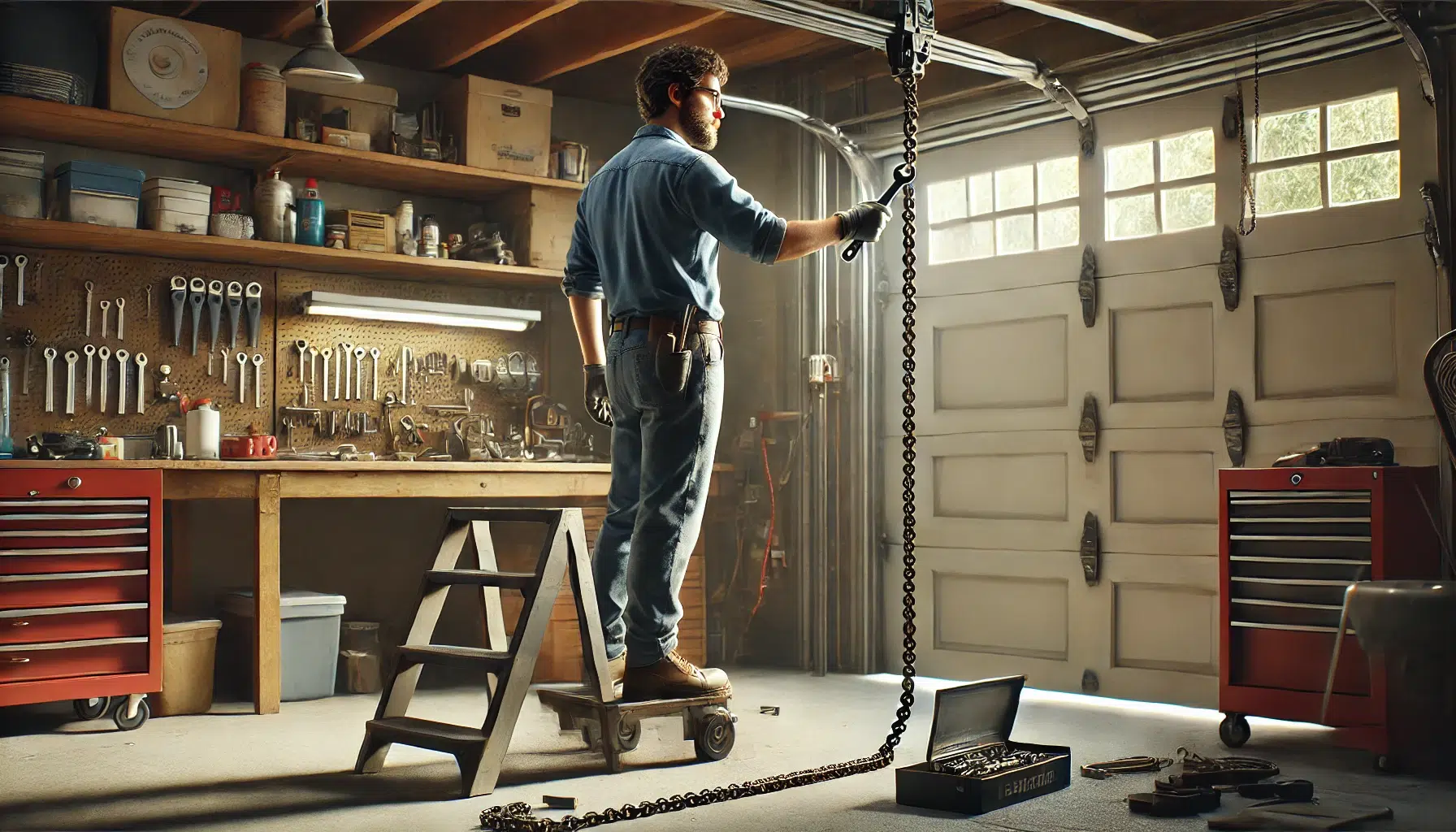
How Do We Solve the Garage Door Chain Loose Issue?
A loose garage door chain can cause numerous problems, from excessive noise to malfunctioning the door mechanism. Proper maintenance and timely adjustments are essential to keep the garage door operating smoothly. This comprehensive guide will walk you through the steps to identify and fix a loose garage door chain, ensuring your door functions correctly and safely. By understanding the underlying causes and knowing how to address them, you can extend the life of your garage door system and avoid costly repairs.
Tools and Materials Needed
- Wrench Set: A set of wrenches (typically 7/16” and 1/2”) is essential for adjusting the nuts on the chain.
- Socket Set: Useful for reaching and turning bolts and nuts in tight spaces.
- Screwdriver (Flathead and Phillips): Needed for removing and securing screws on the garage door opener components.
- Step Ladder: Provide the necessary height to access the chain and other garage door opener parts.
- Safety Glasses: Protects your eyes from debris and accidental injuries.
- Gloves: Ensures a firm grip and protects your hands from sharp edges and dirt.
- Garage Door Lubricant: A special lubricant designed for garage door components, preventing rust and reducing friction.
- Measuring Tape: Used to measure the sag in the chain and ensure proper tension.
- Owner’s Manual: This manual is specific to your garage door opener model and guides adjustment points and specifications.
Step-by-Step Guide
1. Safety First
- Disconnect Power: Unplug the garage door opener to prevent accidental activation while working.
- Wear Safety Gear: Safety glasses and gloves are crucial for protection during the repair process.
2. Understand the Garage Door System
- Identify the Opener Type: Chain-driven garage door openers have a rail that guides the chain, driven by a motor. Familiarize yourself with these components.
- Locate Adjustment Mechanisms: Find the trolley or carriage adjustment nuts that tighten or loosen the chain.
3. Diagnose the Problem
- Visual Inspection: Look for visible wear, rust, or damage on the chain and related components.
- Test the Door: Manually open and close the garage door to observe chain behavior and check for excessive slack or unusual noises.
- Measure Chain Tension: Use a measuring tape to check the sag in the chain. The typical acceptable sag is around 1/2 inch.
4. Adjust the Chain Tension
- Access the Adjustment Nuts: These are usually found near the chain attached to the trolley.
- Tighten the Chain:
- Use two wrenches to hold the inner nut and turn the outer nut clockwise.
- For models with a threaded rod, turn the nut on the rod to adjust the tension.
- Do not overtighten; the chain should have some sag, per the manufacturer’s recommendation.
- Test the Adjustment: Move the door again to check the chain tension and ensure smooth operation.
5. Lubricate the Chain
- Apply Garage Door Lubricant: Spray the lubricant along the entire chain length.
- Spread Evenly: Wipe off any excess lubricant to avoid attracting dust and debris.
6. Check and Adjust Other Components
- Inspect the Rail: Ensure the rail is aligned and securely fastened.
- Check the Sprocket: Look for wear or damage on the sprocket and replace it if necessary.
- Adjust the Limit Switches: These control the door’s travel limits. Ensure they are correctly set to prevent over-traveling and chain slack.
7. Reassemble and Test
- Reconnect Power: Plug the garage door opener back in.
- Test the Door Operation: Use the remote to open and close the door several times, observe the chain’s movement, and listen for any unusual noises.
- Fine-tune adjustments: Make minor adjustments to the chain tension and limit switches if needed.
8. Regular Maintenance
- Routine Inspections: Regularly inspect the chain and other components for signs of wear or damage.
- Lubrication Schedule: Lubricate the chain and other moving parts at least twice a year.
- Professional Check-Up: Consider an annual inspection to ensure the system’s overall health.
Troubleshooting Tips
- Chain Still Loose: If the chain remains loose, there may be an issue with the tension spring or trolley. Consult the owner’s manual or a professional for further diagnosis.
- Noisy Operation: Ensure all components are properly lubricated, and the chain is not over-tightened.
- Uneven Door Movement can indicate tracks, rollers, or alignment issues. Inspect and adjust or replace as needed.
FAQs on Solving a Loose Garage Door Chain Issue
1. What causes a garage door chain to become loose?
A garage door chain can become loose due to several factors, including:
- Normal Wear and Tear: The chain can stretch over time and lose tension due to regular use.
- Temperature Changes: Extreme temperature fluctuations can cause the metal components to expand and contract, leading to chain slack.
- Improper Installation: If the chain was not installed correctly, it could quickly become loose.
- Lack of Maintenance: The chain and other components can wear out faster without regular lubrication and adjustments.
- Damaged or Worn Components: Parts like the sprocket, trolley, or tension spring can wear out or get damaged, causing the chain to lose tension.
2. How often should I check and adjust the garage door chain tension?
- Routine Checks: It’s advisable to visually inspect the garage door chain every few months. Look for signs of wear, rust, or sagging.
- Adjustments: If you notice the door operating noisily or unevenly, you should check and potentially adjust the chain tension at least once a year or more frequently.
- After Extreme Conditions: Inspect and adjust the chain more often if your garage experiences extreme weather or heavy usage.
3. Can I over-tighten the garage door chain?
Yes, over-tightening the garage door chain can lead to several issues:
- Increased Wear: A too-tight chain puts excessive pressure on the sprocket, trolley, and motor, leading to premature wear.
- Noisy Operation: An over-tightened chain can cause the garage door to operate noisily.
- Potential Damage: Excessive tension can damage the motor or cause the chain to snap, leading to costly repairs.
- Proper Tension: Aim for the manufacturer-recommended tension, typically allowing for about 1/2 inch of sag in the chain.
4. How do I know if the garage door chain tension is correct?
To ensure the correct tension of the garage door chain:
- Measure the Sag: Use a measuring tape to check the sag in the chain. Typically, about 1/2 inch of sag is recommended.
- Manual Operation: Open and close the garage door manually. The chain should move smoothly without excessive slack or tightness.
- Noise Levels: Listen for unusual noises during operation. A correctly tensioned chain should operate relatively quietly.
- Visual Inspection: Ensure the chain is taut but not overly tight, and check for any signs of wear or damage.
5. What should I do if the garage door chain is still loose after adjustment?
If the chain remains loose after adjustment:
- Check the Trolley: Ensure the trolley is aligned correctly and not worn out. A misaligned or worn trolley can cause chain slack.
- Inspect the Tension Spring: If the tension spring is worn or damaged, it may not hold the chain tension properly.
- Sprocket Condition: Examine the sprocket for wear or damage. A worn sprocket can cause the chain to slip and become loose.
- Professional Assistance: If you cannot identify or fix the problem, it is advisable to seek help from a professional garage door technician.
6. How can I prevent my garage door chain from becoming loose in the future?
Preventing a garage door chain from becoming loose involves regular maintenance and proactive measures:
- Regular Inspections: Conduct routine checks for signs of wear, rust, or slack in the chain.
- Lubrication: To reduce friction and wear, apply garage door lubricant to the chain and other moving parts at least twice a year.
- Proper Adjustments: Adjust the chain tension to maintain the recommended sag and ensure smooth operation.
- Professional Maintenance: Schedule an annual inspection and maintenance service with a professional to address any potential issues before they become significant problems.
- Protect from Extreme Conditions: If possible, protect your garage door system from extreme weather conditions that can cause metal components to expand or contract.
7. Is adjusting the garage door chain safe, or should I hire a professional?
Adjusting the garage door chain can be done safely by following proper procedures, but there are considerations:
- Basic Adjustments: If you have basic mechanical skills and follow the steps outlined in your owner’s manual, you can safely adjust the chain tension yourself.
- Complex Issues: If the chain remains loose after adjustments, or if you notice other issues like worn components or misalignment, it is best to hire a professional.
- Safety Concerns: Always prioritize safety by disconnecting power before starting any adjustments and wearing appropriate safety gear.
- Professional Expertise: Professionals have the experience and tools to diagnose and fix complex problems, ensuring your garage door operates safely and efficiently.
8. What types of lubricants are recommended for a garage door chain?
For lubricating a garage door chain, it’s essential to use the right type of lubricant:
- Garage Door Lubricants: Specifically designed for garage door components, these lubricants reduce friction and prevent rust without attracting dust and debris.
- Silicone-Based Lubricants: Effective for reducing friction and protecting metal components without gumming up.
- Lithium Grease: Offers long-lasting lubrication and protection for metal parts.
- Avoid Regular Oil: Regular oils can attract dirt and debris, causing build-up that can interfere with the garage door system’s operation.
Applying the correct lubricant in the right amount helps maintain the chain and other moving parts, ensuring smooth and efficient operation.
Conclusion
Addressing a garage door chain issue promptly can prevent further damage and ensure smooth operation. Following these detailed steps, you can maintain proper chain tension and keep your garage door functioning efficiently. Regular maintenance and timely inspections are crucial to avoid potential problems and extend the lifespan of your garage door system. Remember, seeking professional assistance is always wise if the issue persists or you’re unsure about any step. Taking care of your garage door chain enhances performance and provides peace of mind, knowing your garage door is safe and reliable.



